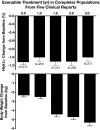Effects of exenatide on diabetes, obesity, cardiovascular risk factors, and hepatic biomarkers in patients with type 2 diabetes
- PMID: 19885351
- PMCID: PMC2771486
- DOI: 10.1177/193229680800200214
Effects of exenatide on diabetes, obesity, cardiovascular risk factors, and hepatic biomarkers in patients with type 2 diabetes
Abstract
Obesity increases the risk of diabetes up to 90-fold and worsens hyperglycemia, hyperinsulinemia, insulin resistance, dyslipidemia, and nonalcoholic fatty liver disease. For patients with type 2 diabetes, weight loss can trigger improvements in all these conditions and decrease the need for glucose-lowering agents. The incretin mimetic exenatide shares many glucoregulatory properties with native glucagon-like peptide-1, including enhancement of glucose-dependent insulin secretion, glucose-dependent suppression of inappropriately high glucagon secretion, slowing of gastric emptying, and reduction of food intake in patients with type 2 diabetes. Exenatide treatment was associated with progressive weight loss in the majority of patients in clinical trials. In addition, patients with elevated markers of liver injury at baseline showed improvements. Therefore, exenatide represents a unique option for adjunctive therapy for patients with type 2 diabetes not achieving adequate glycemic control on oral antidiabetic agents, especially in patients for whom weight gain would be an additional contraindication.
Keywords: NAFLD; exenatide; obesity; type 2 diabetes.
Figures

References
-
- Anderson JW, Kendall CW, Jenkins DJ. Importance of weight management in type 2 diabetes: review with meta-analysis of clinical studies. J Am Coll Nutr. 2003;22(5):331–339. - PubMed
-
- Maggio CA, Pi-Sunyer FX. Obesity and type 2 diabetes. Endocrinol Metab Clin North Am. 2003;32(4):805–822. - PubMed
-
- Stein CJ, Colditz GA. The epidemic of obesity. J Clin Endocrinol Metab. 2004;89(6):2522–2525. - PubMed
-
- Mokdad AH, Ford ES, Bowman BA, Nelson DE, Engelgau MM, Vinicor F, Marks JS. Diabetes trends in the U.S.: 1990–1998. Diabetes Care. 2000;23(9):1278–1283. - PubMed
-
- Mokdad AH, Ford ES, Bowman BA, Dietz WH, Vinicor F, Bales VS, Marks JS. Prevalence of obesity, diabetes, and obesity-related health risk factors, 2001. JAMA. 2003;289(1):76–79. - PubMed
LinkOut - more resources
Full Text Sources
Other Literature Sources

